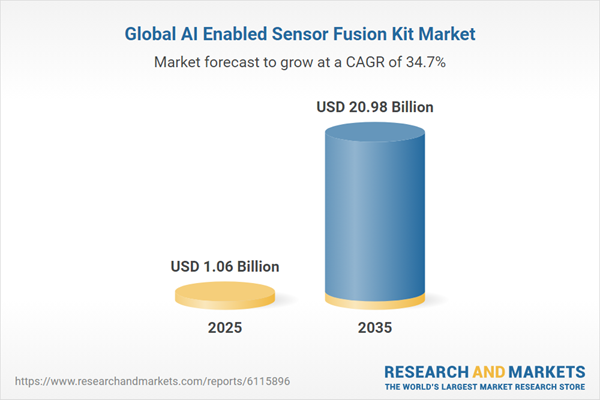This report comes with 10% free customization, enabling you to add data that meets your specific business needs.
One of the major drivers propelling the growth of the AI enabled sensor fusion kit market is the rapid advancement in artificial intelligence and machine learning technologies that allow for real-time sensor data interpretation with higher accuracy. This advancement significantly improves the performance of autonomous systems by reducing latency and increasing precision in decision-making. Additionally, there is a growing demand across sectors such as automotive, defense, agriculture, and healthcare for systems that require contextual understanding and environmental awareness - capabilities that AI-enabled sensor fusion kits are well-suited to deliver.
The second growth pillar of the AI enabled sensor fusion kit market is proliferation of robotics, smart devices, and IoT deployments. Robotics in warehouse automation, precision agriculture, and humanoid applications increasingly rely on multi-sensory input for mobility and perception. Moreover, smart home devices, drones, and wearables are embedding sensor fusion capabilities to enhance user experience, safety, and energy efficiency. The AI-layer embedded in sensor kits enables edge processing, minimizing cloud dependency and allowing for faster autonomous response.
The AI enabled sensor fusion kit market presents strong opportunities for innovation, especially in edge AI integration and domain-specific customization. As edge computing becomes more prevalent, there is increasing interest in compact, low-power sensor fusion kits that can operate without continuous internet connectivity. Additionally, the demand for application-specific sensor fusion platforms - for instance, those tailored for drone navigation, factory automation, or smart mobility - creates opportunities for differentiation through customized sensor arrays, embedded AI models, and modular architectures. Partnerships between AI developers, sensor manufacturers, and OEMs are also opening new avenues for co-developed solutions and accelerated product deployments.
Despite growing demand, the AI enabled sensor fusion kit market faces some challenges. The integration of diverse sensor types with varying data formats and latency requirements can be technically complex and costly. Moreover, ensuring the reliability and accuracy of fused data in dynamic and unpredictable environments remains a significant hurdle. The lack of standardization across platforms and proprietary hardware/software ecosystems further complicates interoperability, limiting mass adoption across certain industries and small-scale manufacturers.
Market Lifecycle Stage
The AI-enabled sensor fusion kit market is in a growth to early development stage. While initial adoption was concentrated in research and defense applications, the technology is now moving toward commercialization in mass-market applications such as automotive ADAS, robotics, and smart cities. Increased R&D activity, standardized protocols, and modular architectures are enabling easier integration into existing systems. However, the market still has room for innovation, especially in lowering costs, improving interoperability, and scaling for consumer applications.Global AI Enabled Sensor Fusion Kit Market Segmentation:
Segmentation 1: by Application
- Autonomous Vehicles and Mobility
- Industrial Automation and Robotics
- Smart Agriculture and Farming Systems
- Environmental and Infrastructure Monitoring
- Consumer and Wearable Electronics
- Aerospace, Defense and Surveillance
- Marine and Underwater Systems
Segmentation 2: by Product
- Navigation and Localization Sensor Fusion Kits
- Perception and Obstacle Detection Kits
- Environmental Monitoring Sensor Fusion Kits
- Motion and Gesture Recognition Kits
- Autonomous Control and Navigation Kits for Mobile Platforms
- Customizable Modular Fusion Kits
Segmentation 3: by Region
- North America - U.S., Canada, and Mexico
- Europe - Germany, France, U.K., Italy, Spain, and Rest-of-Europe
- Asia-Pacific - China, Japan, South Korea, India, and Rest-of-Asia-Pacific
- Rest-of-the-World - South America and Middle East and Africa
Key Market Players and Competition Synopsis
The global AI enabled sensor fusion kit market is at growing phase with presence key players including Mistral Solutions, TIER IV, Synaptics, Intel (RealSense) among others. These companies are early developers through advanced manufacturing techniques, extensive research and development, and strategic partnerships with end-users. Emerging players are focusing on sustainable and cost-effective solutions to meet the growing demand for high-performance fusion sensor kits in several applications. The AI enabled sensor fusion kit market is characterized by intense competition driven by technological advancements, regulatory compliance, and increasing automation sector, leading to rapid innovation and collaboration across the industry automation value chain.Some of the prominent established names in the AI enabled sensor fusion kit market are:
- Mistral Solutions
- TIER IV
- Synaptics
- Intel (RealSense)
- Inertial Labs
- Aeva
- Ambient Scientific
- AXISCADES (ESAI)
- NOVELIC
- Senstar
- Eyeris
- Infineon Technologies
- Renesas Electronics
- Analog Devices
- Xsens (Movella)
This product will be delivered within 3-5 business days.
Table of Contents
Companies Mentioned
- Mistral Solutions
- TIER IV
- Synaptics
- Intel (RealSense)
- Inertial Labs
- Aeva
- Ambient Scientific
- AXISCADES (ESAI)
- NOVELIC
- Senstar
- Eyeris
- Infineon Technologies
- Renesas Electronics
- Analog Devices
- Xsens (Movella)
Table Information
| Report Attribute | Details |
|---|---|
| No. of Pages | 120 |
| Published | July 2025 |
| Forecast Period | 2025 - 2035 |
| Estimated Market Value ( USD | $ 1.06 Billion |
| Forecasted Market Value ( USD | $ 20.98 Billion |
| Compound Annual Growth Rate | 34.7% |
| Regions Covered | Global |
| No. of Companies Mentioned | 15 |









